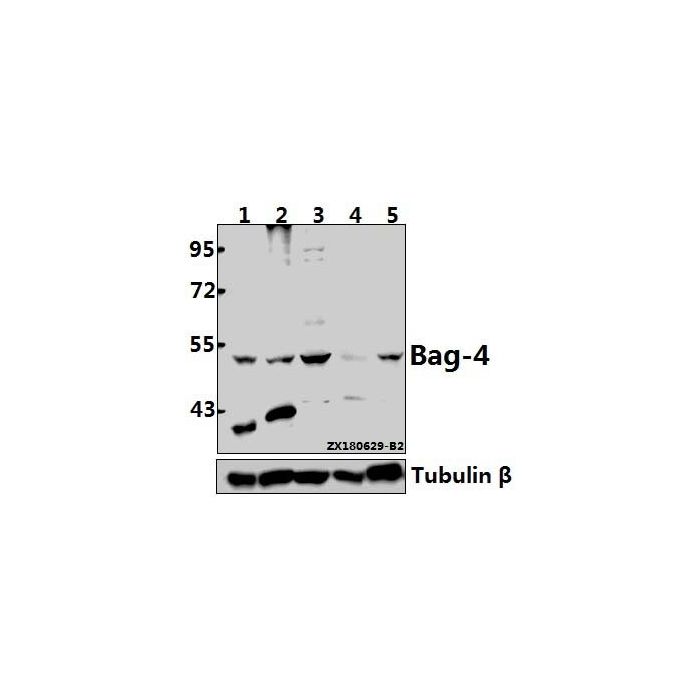Bag-4 (V442) polyclonal, anti-human, mouse, rat
€305.00
In stock
SKU
BS9179
Background:
The cytokine TNF (tumor necrosis factor) signals through the TNF-R1 receptor to activate various cellular pathways, including apoptosis and NFkB activation. TNF binding induces receptor aggregation, resulting in the recruitment of TRADD, FADD, TRAF2 and RIP to the intracellular “death” domain of the receptor complex, which in turn activates signaling pathways including apoptosis and NFkB activation. SODD, for silencer of death domains, was found to be associated with the intracellular “death” domain of TNF-R1 in the absence of TNF stimulation. TNF treatment results in the release of SODD from TNF-R1, allowing the recruitment of TRADD and TRAF2 to the receptor complex. Thus, SODD may play a role in preventing spontaneous signaling by death-domain receptors, in the absence of ligand.
Alternative Name:
BAG 4, BAG family molecular chaperone regulator 4, BAG-4, BAG4, BAG4, Bcl 2 associated athanogene 4, Bcl-2-associated athanogene 4, BCL2 associated athanogene 4, Silencer of death domains, SODD,
Application Dilution: WB: 1:500~1:1000, IHC: 1:50~1:200
Specificity: Bag-4 (V442) polyclonal antibody detects endogenous levels of Bag-4 protein.
Immunogen:
Synthetic peptide, corresponding to amino acids 411-460 of Human Bag-4.
MW: ~ 49 kDa
Swis Prot.: O95429
Purification & Purity:
The antibody was affinity-purified from rabbit antiserum by affinity-chromatography using epitope-specific immunogen and the purity is > 95% (by SDS-PAGE).
Format:
1 mg/ml in Phosphate buffered saline (PBS) with 0.05% sodium azide, approx. pH 7.2.
Storage:
Store at 4°C short term. Aliquot and store at -20°C long term. Avoid freeze-thaw cycles.
For research use only, not for use in diagnostic procedure.
The cytokine TNF (tumor necrosis factor) signals through the TNF-R1 receptor to activate various cellular pathways, including apoptosis and NFkB activation. TNF binding induces receptor aggregation, resulting in the recruitment of TRADD, FADD, TRAF2 and RIP to the intracellular “death” domain of the receptor complex, which in turn activates signaling pathways including apoptosis and NFkB activation. SODD, for silencer of death domains, was found to be associated with the intracellular “death” domain of TNF-R1 in the absence of TNF stimulation. TNF treatment results in the release of SODD from TNF-R1, allowing the recruitment of TRADD and TRAF2 to the receptor complex. Thus, SODD may play a role in preventing spontaneous signaling by death-domain receptors, in the absence of ligand.
Alternative Name:
BAG 4, BAG family molecular chaperone regulator 4, BAG-4, BAG4, BAG4, Bcl 2 associated athanogene 4, Bcl-2-associated athanogene 4, BCL2 associated athanogene 4, Silencer of death domains, SODD,
Application Dilution: WB: 1:500~1:1000, IHC: 1:50~1:200
Specificity: Bag-4 (V442) polyclonal antibody detects endogenous levels of Bag-4 protein.
Immunogen:
Synthetic peptide, corresponding to amino acids 411-460 of Human Bag-4.
MW: ~ 49 kDa
Swis Prot.: O95429
Purification & Purity:
The antibody was affinity-purified from rabbit antiserum by affinity-chromatography using epitope-specific immunogen and the purity is > 95% (by SDS-PAGE).
Format:
1 mg/ml in Phosphate buffered saline (PBS) with 0.05% sodium azide, approx. pH 7.2.
Storage:
Store at 4°C short term. Aliquot and store at -20°C long term. Avoid freeze-thaw cycles.
For research use only, not for use in diagnostic procedure.
| Is Featured? | No |
|---|
Write Your Own Review

